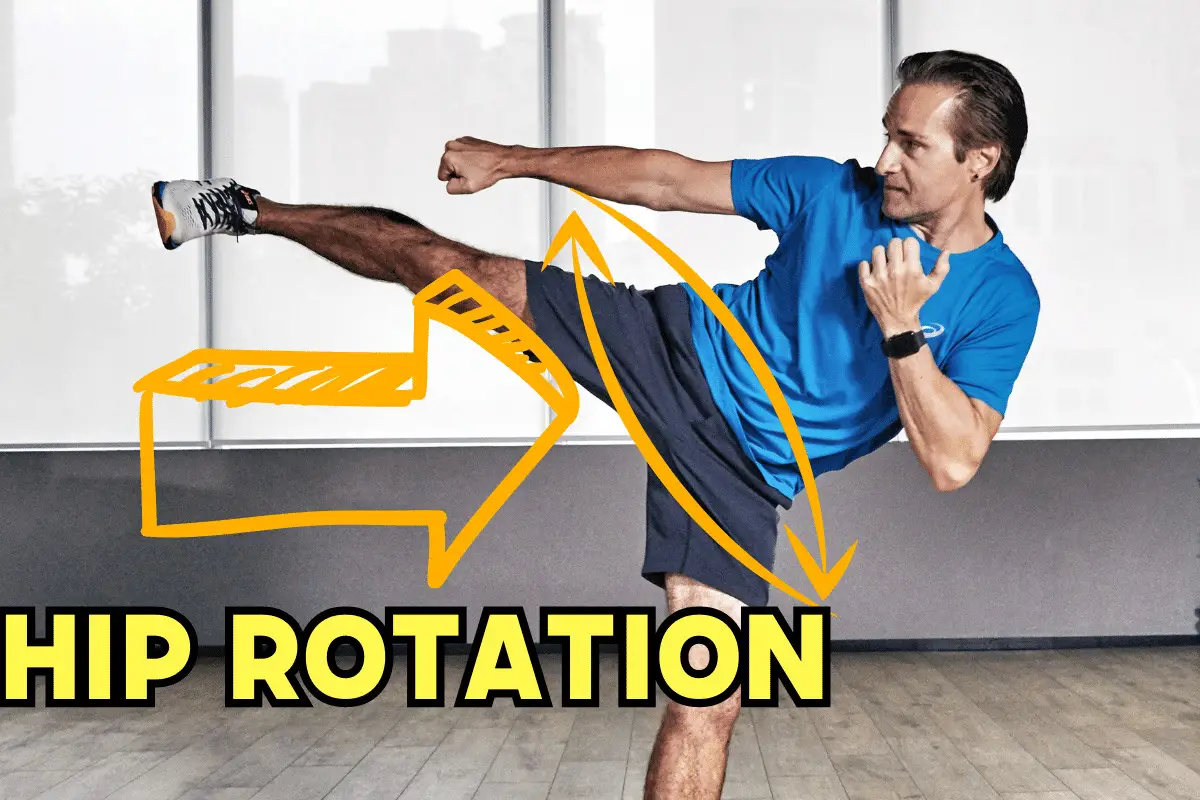Immersing yourself in the realm of Muay Thai kicks can be quite difficult, to say the least. Kicking is the least intuitive motion you’ll learn on your Muay Thai journey. Punching, for instance, is much more intuitive and will take less time to learn and become comfortable with.
Therefore, I’ve decided to write this article. Whether you’re struggling with your kicks or just want to put on more power with them, the things we’ll discuss in this article will apply to you. I’ll also give examples of real kicks you want to learn and explain how to execute them throughout this article.
Now this article is an equal exchange, let me tell you why. I’ve described what this article will do to you: help you kick stronger. But, you must invest something in return. In the case of this article, it’s going to be effort.
Without going to your fighting gym and putting in the hours training and honing your technique, you won’t see many results. While reading combined with visualizing can definitely improve your technique, it’s not enough. Putting in the hours is going to be your investment for this equal exchange. I encourage you to take my advice.
So, whether you’re preparing for your first Muay Thai class or looking to take your skills to the next level, prepare to immerse yourself in the world of Muay Thai kicking. Let’s lay the foundation for your kicking journey and unlock the secrets to delivering kicks that leave a lasting impact on the mat.
#1 – Master the Basics
The first tip, also the most obvious one, is to master the basics. The fact that it’s obvious doesn’t mean overrated. In fact, I would argue the opposite. It’s one of the most underrated and least-used ways Muay Thai fighters use to improve their technique, let it be any striking or defensive technique.
Before focusing on power, ensure you have a solid foundation in the basic kicking technique. Work with your instructor to refine your form and ensure you’re using the correct muscle groups.
That means starting slow and amping up the pace. So what are the basics of kicking and how can you master the basics easily?
Here are a few key points you want to ensure you get right:
- Stance
- Guard
- Chambering
- Foot Positioning
- Returning to Your Fighting Stance
- Raising Your Knee Before Extension
- Target Selection
Every kick you learn will be a different combination of the points above. So for every kick you learn, you must start as slow as possible and amp up the pace only when you notice you have mastered all the points above.
Throughout this article, we’ll review a few of the points above, such as Chambering; so stay tuned to learn how you can perfect them in your Muay Thai kicking journey!
#2 – Warm Up Thoroughly
The second tip is to warm up thoroughly. We all know what it feels like to kick when your body is cold compared to when it’s warm. When it’s cold, you feel your muscles trying really hard to be flexible. Typically, this is how you injure yourself. Warming up is the best way you can use to avoid injuries.
Always warm up before practicing kicks to prevent injuries and enhance your flexibility. Incorporate dynamic stretches and light kicks to prepare your muscles.
When your body is warmed up and stretched, you’ll be able to kick much higher and pack more force. In fact, I would go as far as saying that you won’t be able to learn all the kicks properly if you’re not warmed up sufficiently.
So make sure to warm up and stretch before you practice any Muay Thai kick.
#3 – Use Your Hips
The 3rd tip is one that many, many Muay Thai fighters get wrong. This step is all about using your hips. We all know how difficult it is to generate a lot of power with our kicks. Most fighters will find it more manageable to power up their punches, as they’re easier to control and more intuitive for us human beings.
There’s one trick that many disciples overlook. That is that you generate most of the power from your hips, and not your quads, hamstrings, or calves. These can be helpful to generate more force. However, we’re talking about most of the force, which I’m telling you comes mostly from pivoting the hips.
Power in Muay Thai kicks comes from hip rotation. As you kick, pivot on your supporting foot and engage your hips to generate maximum force.

You must ensure you perform this step properly to generate more force with your kicks. You clicked on this article because you wanted to learn how to kick better. Well, here I am telling you that to do so, you must work on your hip rotation.
If you’re going to continue overlooking this step, you won’t be able to improve your power and technique, so you won’t get better.
#4 – Chamber the Kick
The 4th tip is not less critical than the previous one (utilizing your hips for power.) This is a step that many novice Muay Thai trainees fail to notice. For those of you who fail to notice and use it in your kicking technique, it’ll be more difficult to alchemize the kick you’re executing to generate both force and speed.
Proper chambering is crucial for generating power. Pull your knee up towards your chest before extending your leg to deliver the kick. You must divide the kicking motion into two steps; the first is pulling your knee to your chest and the second is to extend it on the target you’ve selected.
The same applies to the elbows you throw. You must also chamber them to ensure you’re capable of causing any substantial damage to them.

If you don’t divide the motion into the chamber and extension, your kicking technique will be horrible. You’ll simply extend it from your fighting stance, which is bad.
If you want to read more about proper Muay Thai fighting stance and how to perfect yours, follow this link.
#5 – Focus on Balance
The next tip to kick better in Muay Thai is to focus on balance. First, balance means not falling to the ground after throwing a kick. However, it also means maintaining your stance once you’re done with the execution.
Maintain good balance throughout the kick. Keep your guard up, core engaged, and return to your stance quickly after each kick.
Notice how the Muay Thai fighter returns to his fighting stance after he’s done with the Roundhouse kick. You must do the same to ensure you’re capable of continuing to fight at your best, regardless if you hit or miss.
If you want to learn about the best Muay Thai combinations for beginners, including some with kicks, follow this link.
Anyways, the key here is to focus on balance as much as you focus on power and speed. If you can manage to stay balanced when you kick slowly, you’ll also be able to do the same with more speed. So start slowly and amp up the pace when you think you’re ready.
#6 – Work on Flexibility
Flexibility is important for two reasons. The first is related to fighting, which is to kick higher. The second, however, is much more important, which is to avoid injuries in both the short and long term.
Flexibility is essential for high kicks. Regularly stretch your hip flexors, hamstrings, and quadriceps to improve your range of motion.
I recommend stretching either before or after your Muay Thai session. What you’ll notice happening is that, over time, you’ll be able to kick higher without trying. And kicking higher is crucial for throwing better strikes that can hit your opponent’s head.
However, the part I want you to focus on is the injuries part. If you can avoid injuries, you can train for longer. Now training for longer without any injuries will naturally improve your kicks; this is how it works.
If you train Muay Thai in a good fighting gym while bringing no attention to kicks, you’ll still improve them. I want you to understand this point because it’s very important.
If you’re injured, you’re unable to train, which means you’re unable to improve any realm in your fighting skillset. Therefore, by stretching, you’re indirectly improving your kicks in the future. So make sure to work on your flexibility.
#7 – Use Your Arms Properly
Utilizing all your body for one motion is something you’ll learn a lot in Muay Thai. When you throw a Cross, Jab, or Uppercut, you want to use your hips, feet, shoulders, and back to generate more power. The same applies to all the kicks you’ll learn.
More specifically, you want to use your arms when you kick, as that’ll allow you to (1) stay more balanced (2) defend yourself better, and (3) generate more force. Coordinate your arms with your kicks. For example, when executing a Roundhouse kick, swing the opposite arm down to generate more torque.
Another example is the Teep, which can serve as both an offensive and defense move if you didn’t know. You want to swing your left arm down when you throw a left Teep, and the same applies to the right side. That will allow you to create more force, generate more power, and stay more balanced when you throw one.
Swinging your arm when you kick is critical. So from now on, make sure to use your arms when you kick. This can also mean keeping your other arm up to protect your face (keep your guard up.) Indeed, your options aren’t only for offensive purposes—but can also apply for defense.
#8 – Practice with Resistance
The next tip is to practice with resistance or to put it simply, progressive overload. In the gym, you always want to strive to increase the number of reps you can do with a specific weight in the following workout you do. If I bench press 150lbs for 5 reps on Sunday, when I return for the next workout on Tuesday, I want to do at least 6 reps with 150lbs bench press.
This is how you constantly improve your strength when lifting weights. The same, although not many people understand this, applies to Muay Thai. You must constantly strive to do more, to punch harder, to kick higher, to run faster. This is how you improve.
A fantastic way of “putting on more weight” to your kicks is to add resistance bands.
Train with resistance bands or pads to enhance the power of your kicks. This added resistance will help build strength in the kicking muscles, which will help you kick better over time.
And again, I’m giving you a practical step to do here that will help you kick more powerfully over time. This is why you’re reading this article – precisely for these steps. So don’t get lazy and say that you might do it. The next time you’re training your kicks on heavy bags or with Thai pads, put on resistance bands.
#9 – Strengthen Your Core
To become an exceptional Muay Thai fighter, you must work on all your areas of fighting, which includes physical conditioning, strength training, and also improving your core.
A strong core stabilizes your body during kicks and enhances your overall kicking power. Include core exercises like planks, Russian twists, and leg raises in your training routine.
With a strong core, you’ll be able to skyrocket your balance and strength with your kicks. Not only that, but you’ll also be able to do everything better. Make sure to incorporate core training into your weekly training routine.
#10 – Diversify Your Training Methods
Incorporate shadow boxing into your training sessions, focusing on perfecting your kicking technique without the added weight of a bag or pads.
Likewise, incorporate Thai pads workouts and heavy bag training. You can also use resistance bands to further diversify your training routine. The more you do, the more your kicking technique will improve in all its realms.
This is why shadowboxing is also important, as it allows you to work on your technique without any distractions. And this is why using Thai pads and a heavy bag are important training methods as well, as they’ll habituate you to focus on power, speed, and proper technique.
All of these are critical to have in your training routine.

#11 – Listen to Your Body
Avoid overtraining and listen to your body to prevent injuries. Allow sufficient time for rest and recovery between training sessions.
I’ve made most of my mistakes with this tip, which is why I’ve decided to include it as the last one. It’s critical you listen to your body as much as possible. Your body is yours. Keep it healthy and treat it right and it’ll serve you well.
If your body says enough, then it’s time to stop training. If your body isn’t saying anything, you can continue pushing yourself until you find your limits. This is, once again, progressive overload.
What I can do might not be something you can do, and the other way around. So make sure to listen to your body and not put an incredible toll on it, as it’ll be more likely to get overtrained and stop serving you well.
Final Words
Always keep in mind that progress takes time, and each small improvement brings you closer to your goals. Embrace the learning process, and don’t be discouraged by temporary setbacks. Whether you are a beginner or a seasoned practitioner, refining your kicking technique is a constant endeavor, and the rewards are worth every effort.
Make sure to prioritize safety over anything else. So that means pairing yourself with high-quality shin guards before you begin your kicking journey.
If you don’t want to hurt yourself like many people end up doing in their Muay Thai training, I wrote a complete guide to essential Muay Thai gear you must buy to ensure your safety; so make sure to check it out to avoid injuries in one of the most dangerous combative sports on the globe.
Here are other articles you’ll benefit from:

